The Early Days of Classic Cars
Story & photos by Donald-Brian Johnson
“Come away with me, Lucille,
In my merry Oldsmobile.
Down the road of life we’ll fly-
Automobubbling, you and I!”
-Vincent P. Bryan & Gus Edwards, 1905
Since Henry Ford’s first Model T rolled off the Detroit assembly line in 1908, the world’s love affair with the “horseless carriage” has been something to sing about. Vintage autos hold an irresistible appeal to those who long for the days before power steering, GPS, (or even, in some cases, windshields).
There’s A Ford In Your Future
Although automobiles had been introduced in the late 19th century, the Model T was the first affordable auto. Short on frills, but long on durability, the inexpensive “T” meant that middle class folks-the vast majority of the potential buying public-could put away the horse and buggy, and get behind the wheel. During the two-decade (1908-1927) production run of the Model T, over 15 million were manufactured, with a car emerging from the production line every three minutes. The popularity and reliability of the Model T made good on Henry Ford’s initial promise:
“I will build a car for the great multitude. It will be constructed of the best materials, by the best men to be hired, after the simplest designs that modern engineering can devise. But it will be so low in price that no man making a good salary will be unable to own one.”
Although Mr. Ford believed that, with a Model T, who could possibly need (or want), another car, by 1928 consumers were in the mood for more. What Ford viewed as “luxuries” (electric starters, more powerful engines, cosmetic enhancements), other manufacturers touted as “essentials.” Buyers bought into the hype, and 1928 saw the introduction of the Model A.
Henry Ford had actually started off in 1903 with an unsuccessful Model A, working his way down through the alphabet until hitting on the blockbuster Model T. But, since the 1928 Model A was trumpeted as a new beginning for Ford, it was back to the beginning of the alphabet. The “new and improved” Ford was an immediate hit with buyers, even inspiring a popular song (Henry’s Made A Lady Out Of Lizzie). Even better, it came in four colors.
The Little Ford Rambled Right Along
Of course, Ford wasn’t the only auto manufacturer on the early twentieth-century market, even if at times it seemed so. Oldsmobile, Buick, Chrysler, and other venerable names attracted hordes of buyers at the time, and continue to attract hordes of present-day collectors. But what guides the choice? In the words of collector Bill Haire, “what you restore is what you remember.”
“How do people find themselves bitten by the antique auto ‘bug?’ Well, many of us had our first exposure to an old car while teenagers, the age when most young men seem to be attracted to autos.
“In 1957, when I was a sophomore in high school and growing up on a farm, my younger brother and I gave a neighboring farmer five dollars for a 1929 Model A (which I found out later was a Special Coupe).
“The farmer had converted the ‘A’ into a field wagon. At the end of the farming season, the engine failed him, so he parked the car under a tree and used a tree branch to hoist out the engine. He decided to give up on repairs, and sold us the car ‘where is and as is’.
After closing the deal, my brother and I took a farm truck to the ‘shade tree garage’ and towed the car out from under the tree, then sifted through the dirt to find the engine parts where the farmer had dropped them. We took the car, and several bushel baskets of parts, back to our farm shop.
“During the remainder of our high school and college years we drove the ‘A’ whenever we had the opportunity, through mud holes, across fields hunting pheasants and rabbits, to country softball games, and to many other events. After college graduation, I went back to my home community to teach. I was so busy I had no time to drive the ‘A.’ It sat beside an obsolete manure spreader in an unused granary until 1998, when I brought it to Omaha, and began what would be a three-year restoration project. I stripped it down to the frame and built it back to its original condition, with the addition of a rumble seat and a fender-mounted spare tire. I did all the restoration, with the exception of the body and paint work, and it was truly a labor of love. Those who love old cars, and get great satisfaction from transforming junk into beauty, will understand how the time, frustration and skinned knuckles are justified by the final product.
“When I finished the restoration, I sold the Model A to my brother for my out-of-pocket cost on the project, less $2.50 (his half of the original purchase price). It’s back on the family farm where we towed it in 1957, but now enjoys a parking spot in a cozy garage.”
Gasoline Alley
While most restorer/collectors take pride in to-the-last-bolt restoration accuracy, (autos entered in competition must, in fact, conform to official restoration standards), there are other paths to follow. Ronald Iske took equal, and justifiable pride in his 1924 Model T. “Restored?” said Ronald, “Naw, I just built it from parts.” The retired rural route mailman and farmer always wanted a “T” because “that’s what my great-grandfather had.” His “from scratch” model came complete with an original “Fat Man” steering wheel, hinged to accommodate even the heftiest drivers. Asked how long it took to come up with the finished product, Ronald thought a moment: “About 45 years.” (long pause) “Well, I had to work, you know.” Like many of the restored autos, Ronald’s Model T ran like a dream, an achievement he was more than happy to demonstrate.
Car collecting isn’t solely the bailiwick of self-taught handymen. There are those who long for an auto “just like Granddad’s,” but lack the mechanical know-how to make that happen. For those interested in learning, the information age means that almost every “how-to” hint on car restoration, (and almost every part, whether new or re-fabricated), is available online. For those interested in leaving the learning to someone else, professional restoration and repair shops run a bustling business. Vintage autos can also be purchased in fully restored condition, although the cost will be considerably higher than a do-it-yourself-er. Depending on make and condition, there are un-restored autos available for well under one thousand dollars. A fully restored, showroom-fresh Model T can run over twenty thousand.
Collector clubs are a plus for those interested in restoring classic cars, or even just learning more about them. Both domestically and internationally, there are clubs for almost every make and model. Many publish newsletters chock-full of interest: auto history, upcoming events, (did you know the first vintage auto show dates back to 1931?), plus must-have meat-and-potatoes info: “where-to-find-it” and “how-to-do-it.” Even more importantly, these clubs offer a gathering spot for those with a common interest in autos. In the words of Barney Deden, they “generate a strong sense of camaraderie and lifetime friendship.”
Many in-demand vehicles have now reached the 100-year mark, with others fast approaching that manufacturing milestone. As these were items-for-use (outdoor use, at that), there was little protection against the elements (no underbody rust protection sealant way back when). It’s a wonder that so many of the cars have survived. Early models not traded in or demolished were driven (or pushed, or towed), into whatever roomy storage shed or barn was handy. Those who collect and restore vintage autos are the eternal optimists, seeing past the dents, tears, and bird nests to the inherent possibilities. With many collectibles, the collector is just an observer. With vintage cars, collectors become active participants. “Why, with just a little elbow grease,” they enthuse, “that thing could be up and running like new!”
And you know what? They’re almost always right.
Autos shown were on display during “Vintage Wheels at the Fort,” an exhibition held annually in Omaha, Nebraska. Full details on this Douglas County Historical Society event can be found on the Society’s website: douglascohistory.org
Photo Associate: Hank Kuhlmann. Research materials courtesy of Barney Deden.
Donald-Brian Johnson is the co-author of numerous books on design and collectibles, including Postwar Pop a collection of his columns. He drives a Jeep. Please address inquiries to: donaldbrian@msn.com


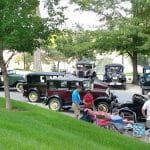
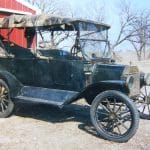

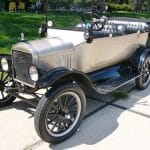
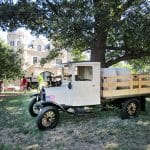
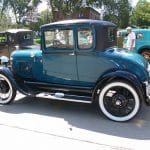



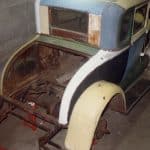

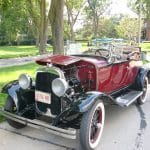
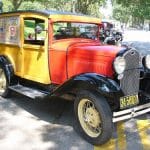

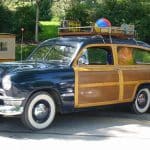
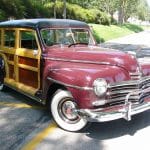



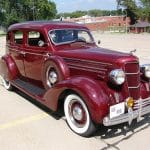
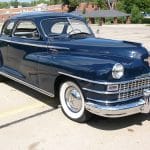
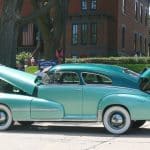
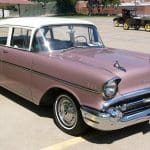
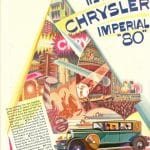
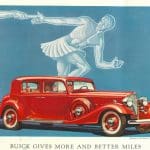



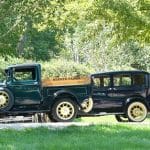



Related posts: